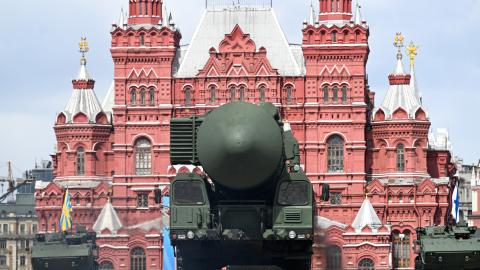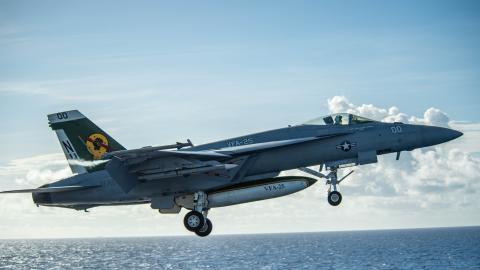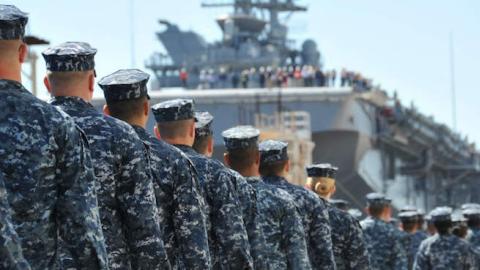__Editor’s Note: This article is adapted from the author’s remarks at the two-day Distributed Lethality Summit, convened by the Commander of U.S. Naval Surface Forces.__
Death and destruction in combat is a difficult subject that has been considered at one time or another by most of us who have served our country in uniform. But for the majority, the consideration was more of a philosophic endeavor than something we were actually likely to face.
I want to open a dialogue with you. I urge you to begin to think, talk, and write more openly about the rigors of combat, combat against a peer or a near-peer adversary and its inevitable result. In these discussions, we have to begin to slowly, reservedly, carefully, and soberly remind our political leadership, the American public and in some cases, ourselves, that we are in a business of great violence, and that in combat with capable opponents, there is the potential for great loss.
I urge this contemplation upon you because much of today’s discussion of naval power focuses on “survivability,” which, while often couched in the language of ship design and architecture, really comes down to a measure of the ability to protect the people inside the skin of the ship, maintain some measure of combat effectiveness under fire, and bring sailors home safely when combat is over.
Survivability has risen as a desired attribute in ship design in no small measure because, for quite a long time, there was little on the seas in the way of a threat whose defeat rose to the level of being worth dying for, and there were precious few opponents who could realistically bring about that end anyway.
In fact, we built and operated a Navy in the post-Cold War era that reflected this. We created a fleet architecture that raised defense to a high art. We became proficient in the art of precision land-attack and maritime constabulary missions while the surface force essentially abandoned the playing field of offensive naval warfare. Because there was no anti-submarine warfare threat to speak of, we walked away from the mission while turning our sonar techs into .50 cal gunners and visit, board, search, and seizure crew. We walked away from the anti-surface mission to the point where we haven’t built a ship in the United States that could kill another ship over the horizon since USS Porter in 1999.
And then, there is Littoral Combat Ship (LCS). I am not a critic of the LCS. I reserve a bit of intellectual humility on the subject, enough to suppose that some really smart people — far smarter than I — sat down and thought hard about what they were doing when they designed its variants.
What is important about LCS is the degree to which “survivability” has dogged this ship’s painful path to the fleet and continues to dog it to this day. Putting aside for a moment the inconvenient fact that it was purposefully designed and acquired to a relatively low standard of survivability (one it meets, by the way), it has always suffered by comparison with its AEGIS forebears. This comparison has been — in my view — aided and abetted by those unwilling to look naysayers in the eye and tell the truth, or at least this version of the truth. Which is that in modern war against peer competitors with wicked weapons supported by persistent and quality intelligence, surveillance, and reconnaissance, nothing in any domain is safe: not LCSs, not destroyers, not attack submarines, not aircraft carriers, not long-range bombers, not land-based tactical aircraft, not armor or artillery or infantry. Nothing. If we fight against a capable opponent or opponents, ships will sink and people will die. Many of each.
Lacking a worthy opponent who could kill us in great numbers, we built ships that we believed were impervious and we also created an aura of fleet invincibility. AEGIS was the envy of the world. We owned it and it would protect us. It was expensive, capable, and safe. We could operate where we wanted, when we wanted, and we could do so with enough striking power to deter you from aggression either by denying your effectiveness, raising the punishment stakes for your conduct, or most likely, by the threat of reversing your gains with massive follow-on forces. This aura of invincibility was well-funded by Congress, and we quite naturally created a group of authorizing and appropriating politicians who bought into it — nay, they came to expect it. We existed in a world in which actual sea combat became remote, and we reinforced that idea with exquisite technology.
But it isn’t 2001 anymore, or 2005. Things have changed and they have done so dramatically. And so must we.
Please don’t think that I am advocating a lot of tall talk and bravado. And I am certainly not suggesting that we should be dismissive or flippant about human life when we talk with the public, the press, or our political leadership.
We have to be begin to be more direct about what we face. We have to recognize that our unchallenged mastery is now challenged. We now have to recognize that there are nations who see the system we’ve crafted since World War II as unhelpful to their strategic goals. We have to recognize that in order to deter nations like this, naval forces operating weeks over the horizon are insufficient. We must recognize that presence, showing the flag, being there, is just not enough.
Distributed lethality is the leading edge of that recognition. By increasing the unit-level lethality of virtually every ship in the Navy and then operating them innovatively in a dispersed posture designed to present an adversary with numerous and diverse threats to what he holds dear, we are once again realizing the deterrent value of offensive power. The surface force seems to have recognized the changed environment, the re-emergence of great power dynamics, and the requirement to break a defensive mindset while taking to the operational offensive once again. Future strike group commanders and numbered fleet commanders and four-stars must begin to think about and more importantly communicate a recognition that the stakes have changed, and that a force that places too much value on survivability may be placing insufficient emphasis on threatening the other guy’s survivability.
My jihad on “survivability” should not be misconstrued. I am not calling for the creation of some kind of a “trip-wire” force of what might be considered expendable, such as fast patrol craft bristling with offensive weapons. While such a capability gets the heart beating fast with images of junior officers zorching around the Philippine Archipelago, the key to presenting the other guy with an effective Phase 0 and 1 deterrent is not only widely distributed offensive power — but also a base-level of electronic warfare and self-defense anti-air warfare capability resident on every one of those platforms. This isnot simply to mollify those who would question the survivability of those assets, but for the strategically worthwhile goal of raising the cost to the adversary of his first move. Put another way — we’ve got to make things tougher on the other guy.
We need to harden surface presence forces not just for the sake of protecting the people serving on the ship, but also to present would-be aggressors with a more effective deterrent. We need — when we talk about survivability — to ensure that we are talking about it as a means to an end — conventional deterrence — and not an end unto itself.
So when we look at what has happened to the LCS program since January of 2015, I am heartened by the approach that I’ve seen discussed in the media about the upgrades that will flow to the follow-on frigate program, to include over the horizon missiles, a robust anti-submarine warfare system, and an enhanced electronic warfare capability, as well as a more robust self-defense anti-air warfare suite. As far as I’m concerned, the faster the better. Clearly, the Office of the Secretary of Defense wanted the Navy to increase both the lethality and the survivability of the ship, and to that extent, it appears to me that the Navy has chosen largely to use lethality to enhance survivability — in other words, the best defense is a good offense.
Survivability can be a bit like stealth in its capacity to run up platform costs. Ultimately, the other guy gets a vote in each case, and it appears that his options for overcoming our investments in survivability and stealth are often more cost-effective than our efforts to achieve these attributes.
This is why I am far more in favor of enhancing survivability through offensive lethality and electronic warfare systems, rather than more armor, increased compartmentation, or other elaborate damage control measures.
Finally, I want to try and get something going here with you. I’d like us to stop talking about “survivability” altogether. That’s right — eliminate it from our lexicon. When you folks go back to your jobs wherever they may be, but especially at the Pentagon, the systems commands, or at the surface type command, try to get the Navy to walk away from it. Truth be told, it is a loaded term, and one that conveys defense and weakness and timidity. The Air Force — which has a much tougher job in justifying the expense of large land bases that don’t move — never talks about “survivability.” They talk about “hardening,” as I’ve done here today.
We need to harden the surface force in order to make our adversaries spend more of their tax dollars in trying to overcome it — or better yet — decide that such expenditures aren’t worth the opportunity cost. This is, of course, the essence of conventional deterrence.

















